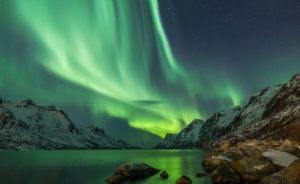
If you’re lucky enough to have a clear sky and are located in the northern hemisphere you may have seen spectacular colours playing across the sky in greens, pinks, and purples. These lights, in the northern hemisphere, are called the aurora borealis which are waves of dancing light that illuminate the sky. If you are a frequent visitor to Norway or Iceland you are likely familiar with this display, but what causes these lights and why is autumn/winter the best time to view them?
Aurora can be seen near both the north and south poles, however, in the south, it is called the aurora australis. For millennia, the lights baffled humans as they tried to understand what caused this light spectacle. The answer comes from the sun. Solar storms on the sun’s surface cause large waves of electrically charged particles to travel millions of miles into the solar system. Many of the particles are deflected away from Earth, but sometimes they become captured in the Earth’s magnetic field and quickly are pulled into the atmosphere and towards either of the Earth’s poles.
When these energized particles from the sun slam into the Earth’s upper atmosphere at speeds of 45 million miles per hour (mph), atoms and particles begin to heat up and much like when you heat gas – it begins to glow. The waves are even caused by the Earth’s magnetic field which sees these particles dance across the sky. When these particles come into contact with oxygen in the atmosphere, they are heated to produce the familiar green colour of the Aurora, however often we see hints of purple, blue and pink which are caused by the heating of nitrogen particles in the atmosphere.
Galileo Galilei first coined the term ‘Aurora Borealis’ in 1619 named after Aurora the Roman goddess of dawn, and the Greek god of the north wind Boreas. Civilisations across the world have marvelled at the phenomenon with myths and legends going back years outlining its cause being linked to spirituality, death, and battle.
The solar winds which cause the charged particles to reach Earth are constantly at work, however, the sun’s emission goes through a roughly 11-year cycle of activity. In 2023 we are reaching the end of the sun’s solar cycle which is predicted to enter a new cycle in 2024 or 2025. Therefore, we are currently experiencing an increase in the number of sunspots, which are large fields of magnetic pressure on the surface of the sun, causing more changes and auroral activity. Therefore, as we begin to move into the autumn and winter months following the Autumn Equinox the days are getting shorter, so we have more time with dark skies – perfect for hopefully catching a glimpse of this phenomena.
Many places such as Iceland and Norway are known for seeing dazzling aurora scenes, however as we reach closer to the end of the sun’s cycle and the electrical magnetic energy is increased, places lower down in the northern hemisphere are lucky enough to get to see the lights. The aurora borealis has even been seen as far south as Cornwall and Kent in the UK. Therefore, on the next clear and dark night we are sure to be outside looking at the sky hoping to see such a beautiful natural phenomenon.
Sources:
https://www.space.com/15139-northern-lights-auroras-earth-facts-sdcmp.html
https://www.rmg.co.uk/stories/topics/what-causes-northern-lights-aurora-borealis-explained
https://www.bbc.co.uk/news/uk-66913766







